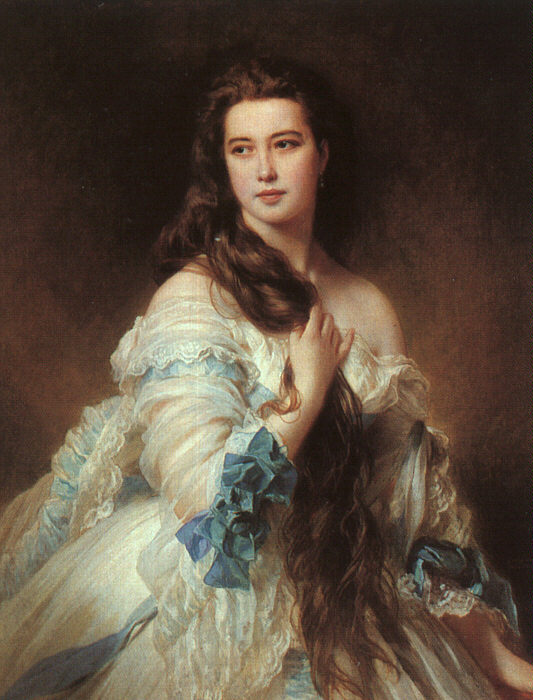
Portrait of Madame Barbe de Rimsky-Korsakov
by Franz Xaver Winterhalter*
The Goddess
by SABA SOBHANIAN
When you enter my grandparents’ house in the Shademan neighborhood in the west of Tehran, the first thing you see are Persian carpets of all sizes hanging on the wall. These colorful carpets belong to my grandfather, who used to sell Persian carpets for a living. Over the years, he bought some of the most beautiful ones to keep for himself, so he could hang them and admire them, but also because they reminded him of his childhood in Isfahan, the birthplace of the Persian carpet. Because he spent so much of his time at the Grand Bazaar of Carpets, my grandfather learned a great deal about the materials and motifs of Persian carpets and grew up to be an expert on them.
The first carpet you see on the wall when you enter my grandparents’ house is a majestic, handwoven carpet set in a gold metal frame. This carpet features a bouquet of jasmine. My grandfather bought the carpet for my grandmother because of her love of jasmine. The golden frame is a perfect match for the white jasmine flowers, and the carpet is so finely woven and delicate, you can see every petal of the flowers in the bouquet. There are so many blossoms in the round white ceramic vase that it’s hard to say how many flowers it holds, but you can easily count the handful of fallen petals that lie on the dark brown table on which the vase sits.
Further on, in the living room, another rug hangs on the wall. This one is even more colorful than the last: in this rug, red, green, blue, and yellow threads come together to form a landscape. In the center of the tableau is a bubbling stream that flows down from the mountains in the background. There are two weeping willows on either side of the picture whose leaves are set aglow by the bright sunshine of a summer day. This rug is older than the others, and it lends a touch of antiquity to the living room. My grandfather told us that this rug was created by a woman from a nomadic tribe, about 50 years ago. He happened to see it in the Grand Bazaar of Carpets in Tehran, and he bought it immediately.
The most valuable carpet, however, hangs on the second floor of the house. It is my grandfather’s favorite. It features the image of a goddess with long, brown hair that pours like a waterfall over her right shoulder. She wears a white ball gown that is set off by puffy, teal-colored sleeves. She has a guileless, innocent look in her eyes as she stares into the distance. She neither smiles nor frowns. When I look at her smile, I am reminded of the Mona Lisa’s smile, one made mysterious, blurry and ambiguous, by the technique of sfumato, leaving much up to the imagination. I have looked at that smile countless times, and I still am left wondering what it means.
The last carpet holds a special place in my heart because the woman in the picture looks so much like my grandmother. And my grandfather agrees. He often says that this carpet is valuable to him not because of its high price but because of the elegance and nobility of the woman it portrays. Now that my grandfather is elderly, he is not be able to go to his shop to sell such colorful masterpieces. But he still holds in his heart the beauty of all the carpets he has ever seen, bought, and sold in his long life; and remembering them nourishes his soul and forever ties him to his past.
* The ‘goddess’ featured in the carpet described in this essay is a likeness of Madame Barbe de Rimsky-Korsakov as portrayed by Franz Xaver Winterhalter.

